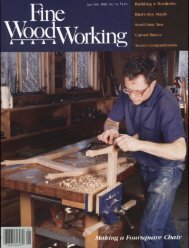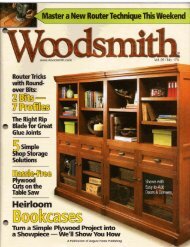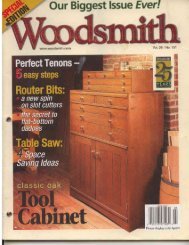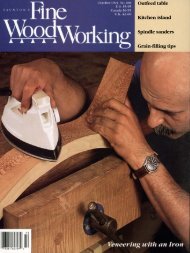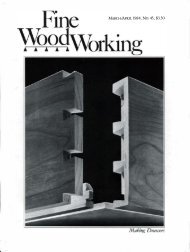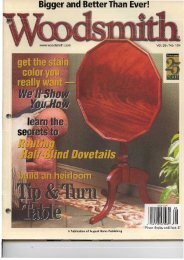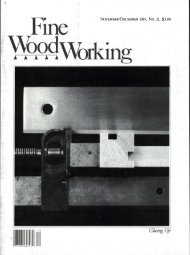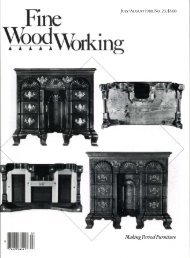Shaping with a Router - MetosExpo - Free
Shaping with a Router - MetosExpo - Free
Shaping with a Router - MetosExpo - Free
You also want an ePaper? Increase the reach of your titles
YUMPU automatically turns print PDFs into web optimized ePapers that Google loves.
Letters<br />
Troubled by current trends-Recently, I set some time aside<br />
to visit several woodworking shows and galleries. I wasn't sure<br />
what I was looking for but I knew there was a trend that was<br />
making me uncomfortable.<br />
Now that I've had a chance to look around and talk to people,<br />
I'm beginning to get a handle on what's wrong. I think it's this:<br />
Woodworking isn't art and never will be. The painter who's fortunate<br />
enough to become a hot item can expect to make a decent<br />
living or even get rich, but people won't pay that kind of money<br />
for woodwork, no matter who made it. However, woodworkers,<br />
who by defInition are starving, refuse to believe this. After all,<br />
wealthy att patrons are their only hope. Therefore, woodworkers<br />
strive vigorously to make their work into art.<br />
This has led to a vicious spiral. Galleries and museums are asking<br />
art curators to jury their shows. These people choose works by<br />
academic criteria. The result is a collection of works that are funky,<br />
brighdy colored, shocking and whimsical-anything but subde.<br />
Lack of function is considered avant-garde.<br />
Up and coming woodworkers see this trend and build accordingly.<br />
At design schools, like Pat-sons and Pratt, the professors adjust<br />
their own work to suit d1e trend, and students at these schools<br />
are tacidy encouraged to build carbon copies of their teachers'<br />
work. So it all looks the san1e.<br />
Don't get me wrong. I'm not bitter because my own work is<br />
being ignored. It's not. In a gallery fIlled <strong>with</strong> purple boxes <strong>with</strong><br />
spikes and orange beads, my rocker is the fIrst thing people ask<br />
about (and often the only thing that sells), which is an object lesson<br />
in itself. The fIner points that make woodworking such a challenge-elegance,<br />
warmth, fInesse, comfort-are also what make<br />
well-crafted furniture a joy to live <strong>with</strong> over the long term. There is<br />
still plenty of room for innovation <strong>with</strong>in these constraints.<br />
-Jeremy Singley, East Middlebury, Vt.<br />
More on Krenov's students-Looking at your article on James<br />
Krenov's students' work was a sheer delight. Special attention<br />
should be paid to Mr. Radenkov's marquetry cabinet, which is so<br />
fIne that I'd be tempted to sell my house and car to buy it. I was<br />
also impressed by Page Sullivan's cabinet; it's nice to see a woman's<br />
work represented.<br />
All the pieces in the atticle illustrate how well the students have<br />
learned Mr. Krenov's basic philosophy of cabinetmaking. However,<br />
I wish there had been more pieces shown and more close-ups of<br />
some of the cabinets. I also would like to have read a bit about<br />
how each student's personal philosophy on cabinetmaking compat"es<br />
<strong>with</strong> Mr. Krenov's approach. 111ere's got to be someone else<br />
out there who feels that a Krenovian-style cabinet would certainly<br />
not be hutt by incorporating some well-proportioned and wellplaced<br />
chip or relief carving, to add to the artistry of the whole piece<br />
<strong>with</strong>out detracting from the subde beauty of a flne-grained wood.<br />
-Dave Koianek, Wolcott, Conn.<br />
Woodcarver blade interferes <strong>with</strong> grinder switch-I recendy<br />
purchased a Bosch right-angle grinder for use <strong>with</strong> a Ryobi Woodcarver<br />
blade. It didn't take long to discover that the design of the<br />
switch on the grinder makes the combination dangerous: When<br />
the switch is on, cutting debris accumulates under the switch so<br />
that it will not turn off. I suspect that this problem could also occur<br />
in any other application that created large quantities of debris, such<br />
as mst scaling. In addition, because the Bosch switch is similar to<br />
the one on my Makita grinder, and presumably to many other<br />
small hand grinders, it is likely that most such grinders will have<br />
the same problem.<br />
I'm now using the grinder plugged into a portable switch-controlled<br />
oudet box, so I don't have to rely on the tool's switch to<br />
turn off the power. 11s solves the problem, but a fIrst-time user<br />
could be caught by surprise.<br />
-Bruce Winterbon, Deep River, Ont., Canada<br />
Even more puzzling-The sidebar "A sliding-tile puzzle" by Robert<br />
Stirling (FW\V #91) was most interesting. 111e very similar plan<br />
was published in a 4-H woodworking manual (Woodworking-Beginner,<br />
Cooperative Extension Service, Purdue Univ., West Lafayette,<br />
Ind. Publication 4H 442) several years ago, and I have made many of<br />
them for gifts.<br />
With only minor alterations, another much more difficult puzzle<br />
can be made, making it a two in one. To make the alternate puzzle,<br />
one of the long rectangular tiles is replaced <strong>with</strong> two small square<br />
tiles, and the large square tile is made thinner so d1at only it will exit<br />
the tray through a slot in one end of the frame. More than 50 moves<br />
are required to move the large square from the upper center to d1e<br />
bottom center (see the drawing below) where it will slip through the<br />
slot. So many moves are involved that when you are successful,<br />
you've forgotten how you accomplished it.<br />
Start<br />
"- - /<br />
;' ',<br />
0<br />
.' 0<br />
c<br />
/ , 1<br />
: '"<br />
I<br />
End<br />
The tiles move easier if they are a bit larger than Mr. Stirling's. I<br />
make the small squares 2 in., the rectangles 2 in. by 4 in. and the<br />
large square 4 in. The large square should be about o/J6 in. thick while<br />
the other tiles are all % in. The slot should be flush <strong>with</strong> the floor of<br />
the tray so the large tile exits easily, but the others are retained. My<br />
name for this puzzle is Le Game. It is really challenging and is handy<br />
for a coffee table or in a waiting room to keep guests occupied.<br />
-0. H. White, Medalyville, Ind.<br />
Bits and braces-As a youth, I had the same question as Noah Birnel<br />
(in FW\V 91, p. 26): How do you fasten an auger bit into the<br />
chuck of a bit brace? I grew up dunking the jaws should grasp the<br />
bit's squared-and-tapered end. But the bit would often fall out of<br />
the brace when I tried to remove it from the work, and I could<br />
rat"ely get the bit straight enough or the chuck tight enough <strong>with</strong><br />
my young hands.<br />
Then as a young man, I discovered the secret. The squared-andtapered<br />
end of the bit fits neady into a square socket located deep<br />
inside the chuck The jaws of the chuck grasp the round shank of d1e<br />
bit, keeping it perfectly straight and centered Ald10ugh it is possible<br />
to pull the bit out of this socket, the jaws prevent it from coming all<br />
the way out of the chuck, even in a very tight hole.<br />
This discovery served me well for more than 25 years w1til I read<br />
Richard Starr's reply to Birnel's question. It prompted me to re-exam<br />
ine my oid Craftsman brace to see whether or not I was crazy. Sure<br />
enough, I learned something new-there are two possible positions<br />
for d1e bit. About % in. inside the chuck, the face of each jaw has a<br />
molded depression shaped to fit the squared-and-tapered end of an<br />
auger bit exacdy. On my brace, it requires a strong light and close<br />
inspection to see d1ese depressions. They allow the bit to be held<br />
further out of the chuck than does the socket deep inside, thus allowing<br />
one to drill a slighdy deeper hole. But even in this position, the<br />
outer ends of the jaws still grip the rounded shank, centering the bit<br />
and preventing it from being pulled out of the brace.<br />
I suggest that Birnel examine the chuck of his own brace closely. A<br />
6 Fine Woodworking



